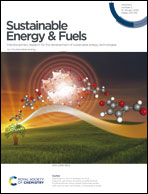Etching C6CoK3N6-induced ZnCdS for improved hydrogen evolution
Abstract
The design and construction of advanced functional structures for photocatalysts has been proven to be an extremely effective approach to greatly enhance their properties toward higher solar-driven water splitting efficiency. Here, by taking advantage of the merits of large specific surface area, open framework structure, large ionic channels and interstices in the lattice and tunable composition of Prussian blue (PB), an open ZnCdS solid solution was obtained for the first time. In detail, the three ZnCdS solid solution derivatives, namely ZnCdS bulk, flake-bulk ZnCdS cage and hollow ZnCdS particle cage were successfully synthesized via C6CoK3N6 induction and NH3·H2O etching at ambient temperature. Interestingly, their specific surface areas and optical properties exhibit clearly visible differences, and their band structures display a stepped distribution. More importantly, the resulting hollow ZnCdS particle cage exhibits more excellent photocatalytic hydrogen evolution activities than the other two derivatives, and the hydrogen evolution rate reached approximately 23 mmol g−1 h−1 under 300 W xenon lamp irradiation with a light power of about 514 mW cm−2. The improved photocatalytic performances mainly benefit from the developed advantages that enriched the active sites, shortened the charge-migration distance, enlarged the surface area, derived more charge transfer channels, enhanced the redox capacity and reduced the reaction overpotential.

- This article is part of the themed collection: Energy Frontiers: Hydrogen


 Please wait while we load your content...
Please wait while we load your content...